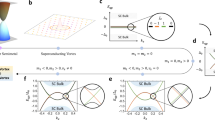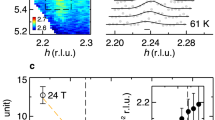Abstract
There is a long-standing debate about whether spin–charge separation is the root cause of the peculiar normal-state properties and high superconducting transition temperatures of the high-Tc materials. In the proposed1 state of matter, the elementary excitations are not electron-like, as in conventional metals, but rather the electron ‘fractionalizes’ to give excitations that are chargeless spin-1/2 fermions (spinons) and charge +e bosons (chargons). Although spin–charge separation has been well established in one dimension, the theoretical situation for two dimensions is controversial and experimental evidence for it in the high-Tc materials is indirect. A model2 with sharp experimental tests for a particular type of separation in two dimensions has recently been proposed. Here we report the results of those experimental tests, placing a conservative upper limit of 190 K on the energy of the proposed topological defects known as visons. There is still debate3 about the extent to which this experiment can settle the issue of spin–charge separation in the high-Tc copper oxides, because some forms of the separation are able to avoid the need for visons. But at least one class4,5,6 of theories that all predict a vortex-memory effect now are unlikely models for the copper oxides.
This is a preview of subscription content, access via your institution
Access options
Subscribe to this journal
Receive 51 print issues and online access
$199.00 per year
only $3.90 per issue
Buy this article
- Purchase on Springer Link
- Instant access to full article PDF
Prices may be subject to local taxes which are calculated during checkout



Similar content being viewed by others
References
Anderson, P. W. The resonating valence bond state in La2CuO4 and superconductivity. Science 235, 1196–1198 (1987).
Senthil, T. & Fisher, M. P. A. Fractionalization in the cuprates: Detecting the topological order. Phys. Rev. Lett. 86, 292–295 (2001).
Moessner, R., Sondhi, S. L. & Fradkin, E. Short-ranged RVB physics, quantum dimer models and Ising gauge theories. Preprint cond-mat/0103396 at 〈http://xxx.lanl.gov〉 (2001).
Senthil, T. & Fisher, M. P. A. Z2 gauge theory of electron fractionalization in strongly correlated electron systems. Phys. Rev. B 62, 7850–7881 (2000).
Franz, M. & Tesanovich, Z. Flux tubes, visons, and vortices in spin-charge separated superconductors. Preprint cond-mat/0010436 at 〈http://xxx.lanl.gov〉 (2000).
Sedgewick, R. D., Scalapino, D. J. & Sugar, R. L. Fractionalized phase in an XY-Z2 gauge model. Preprint cond-mat/0012028 at 〈http://xxx.lanl.gov〉 (2000).
Gough, C. E. et al. Flux quantization in a high-Tc superconductor. Nature 326, 855 (1987).
Wynn, J. C. et al. Limits on spin-charge separation from h/2e fluxoids in very underdoped YBa2Cu3O6+x. Phys. Rev. Lett. 87, 197002 (2001).
Liang, R., Bonn, D. A., Hardy, W. N., Wynn, J. C. & Moler, K. A. Preparation and characterization of homogeneous YBCO single crystals with doping level near the SC-AFM boundary. Physica C (submitted).
Gardner, B. W. et al. Scanning superconducting quantum interference device susceptometry. Rev. Sci. Instrum. 72, 2361–2364 (2001).
Senthil, T. & Fisher, M. P. A. Detecting fractions of electrons in the high-T c cuprates. Phys. Rev. B 64, 214511 (2001).
Beasley, M. R., Labusch, R. & Webb, W. W. Flux creep in type II superconductors. Phys. Rev. 181, 682–700 (1969).
Acknowledgements
We thank T. Senthil, M.P.A. Fisher, S. Sachdev, S. Kivelson, P.A. Lee, R.B. Laughlin and P.W. Anderson for discussions, and R. Lee for technical assistance. This work was supported by NSF CAREER and MRSEC grants, a Terman fellowship, the Natural Science and Engineering Research Council of Canada, the Canadian Institute for Advanced Research and the Institute for Theoretical Physics.
Author information
Authors and Affiliations
Corresponding author
Rights and permissions
About this article
Cite this article
Bonn, D., Wynn, J., Gardner, B. et al. A limit on spin–charge separation in high-Tc superconductors from the absence of a vortex-memory effect. Nature 414, 887–889 (2001). https://doi.org/10.1038/414887a
Received:
Accepted:
Issue Date:
DOI: https://doi.org/10.1038/414887a
This article is cited by
-
Are high-temperature superconductors exotic?
Nature Physics (2006)
-
Can electrons do the splits?
Nature (2005)
Comments
By submitting a comment you agree to abide by our Terms and Community Guidelines. If you find something abusive or that does not comply with our terms or guidelines please flag it as inappropriate.



